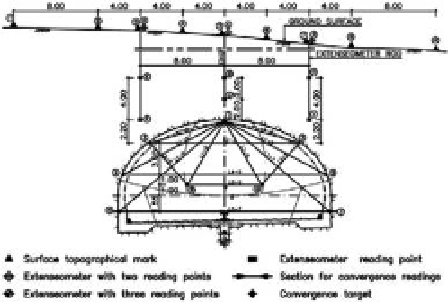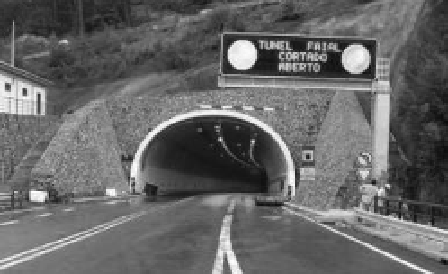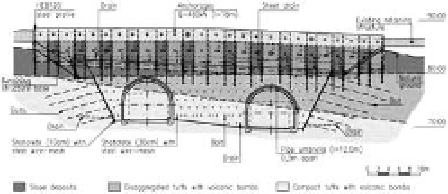Environmental Engineering Reference
In-Depth Information
in general, phreatic line is not considered in the
design due to the permeable water of volcanic for-
mations with good natural drainage conditions.
by the finite element method for the dimensioning
of the primary support and of the final lining.
10
PoRTals
9
oBseRVaTion, alaRM cRiTeRia
The shape of the portals depend on topographic,
geological and geotechnical conditions and land-
scape. The portals must be planned to be harmoni-
ously integrated in the surrounding environment.
Portals in compact basaltic rocks have been con-
solidated with rock bolts and mortar injection.
Portals in breccias and pyroclastic formations
have been consolidated with rockbolts and shot-
crete or reinforced concrete walls. nowadays more
frequently we use to cover the concrete or the shot-
crete with basaltic stones like in the West portal of
For portals in difficult soil conditions, such
as the case of the West portal of caniçal double
tunnel, when due to slope deposits and disaggre-
gated tuffs with volcanic bombs, it was necessary
to build in the upper zone a reinforced concrete
wall with two level of anchorages over the tunnels
and in the lower zone a reinforced shotcrete wall
with a level of anchorages and various levels of
in view of the fairly heterogeneous rock mass
and taking in account the size of the tunnels, a
thorough auscultation is made by means of the
measurement of deformations of the surround-
ing rock mass, apart from the visual, continuous
and systematic observation of the contour of the
excavations and of nearby constructions, in order
to detect possible anomalous behaviour. The main
purposes are to assess the good planning applica-
tion of the construction methods regarding the
effective conditions of the rock mass, as well as
the effectiveness of the designed structures, so as
to compare the design models with reality and also
to support possible design adaptations, improving
the work safety balance.
The auscultation consists on the measurement
of displacements, by methods such as the ones
used in santa cruz tunnels and described next
the absolute level between points in the contour
of the excavation; readings of surface settlements
through topographical marks control and readings
of vertical displacements at the zone overlying the
roof of the tunnels through nine rod strain meters
(three strain meters per each profile located at the
axis of the tunnel and on each wall).
The reading's periodicity of all the observa-
tion apparatus is adapted to the evolution of the
observed displacements. The alarm criteria to be
taken into account during the tunnels excavation is
established based on calculation results performed
Figure 18.
West portal of Faial-cortado tunnel.
Figure 17. current cross-section of location of the
monitoring apparatus.
Figure 19. caniçal double tunnel West portal retaining
structure front view.


















